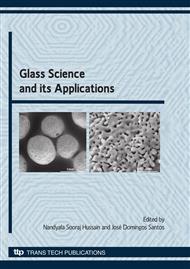[1]
B.O. Healeym, D.R. Walt: Improved Fiber-optic Penicillin Brian, Anal. Chem., 67 (1995), pp.4471-4476.
DOI: 10.1021/ac00120a007
Google Scholar
[2]
C. Preinlnger, I. Klimant, and O. S. Wolfbels: Optical Fiber Sensor for Biological Oxygen Demand, Anal. Chem., 66 (1994), pp.1841-1846.
DOI: 10.1021/ac00083a011
Google Scholar
[3]
B. Koning, O. Kohls, et al: Fabrication and test of sol-gel based planar oxygen optodes for use in aquatic sediments, Marine Chemistry, 97 (2005) pp.262-276.
DOI: 10.1016/j.marchem.2005.05.003
Google Scholar
[4]
O. Wolfbeis: Molecular Luminescence Spectroscopy. Methods and Applications: Part 2 (Wiley, New York, 1988), Chap. 3.
Google Scholar
[5]
J.R. Lakowicz: Quenching of fluorescence: Principles of Fluorescence Spectroscopy: KluwerPlenum: New York (1999), pp.237-265.
DOI: 10.1007/978-1-4757-3061-6_8
Google Scholar
[6]
Y. Amao: Probes and polymers for optical sensing of oxygen. Microchimica Acta, 143 (2003), pp.1-12.
DOI: 10.1007/s00604-003-0037-x
Google Scholar
[7]
J.N. Demas and B.A. DeGraff: Applications of luminescent transition metal complexes to sensor technology and molecular probes. Journal of Chemical Education, 74 (1997), p.690695.
DOI: 10.1021/ed074p690
Google Scholar
[8]
Sang-Kyung Lee and I. Okura: Porphyrin-doped sol-gel glass as a probe for oxygen sensing, Analytica Chimica Acta, 342 (1997), pp.181-188.
DOI: 10.1016/s0003-2670(96)00562-4
Google Scholar
[9]
G. O'Keeffe, B.D. MacCraith, A.K. McEvoy, C.M. McDonagh, and J.F. McGilp: Development of LED-based phase fluorimetric oxygen sensor using evanescent wave excitation of a solgel immobilized dye. Sensors and Actuators B (1995), 29, pp.226-230.
DOI: 10.1016/0925-4005(95)01687-2
Google Scholar
[10]
Win Lu, M.A. Winnik: Luminescence Quenching in Polymer/Filler Nanocomposite Films Used in Oxygen Sensors, Chem. Mater., 13 (2001), pp.3449-3463.
DOI: 10.1021/cm011029k
Google Scholar
[11]
Wenying Xu, R.C. McDonough III, B. Langsdorf, J.N. Demas, and B.A. DeGraff: Oxygen sensors based on luminescence quenching: Interactions of metal complexes with the polymersupports. Analytical Chemistry, 66(1994), pp.4133-4141.
DOI: 10.1021/ac00095a004
Google Scholar
[12]
Xin Lu and M.A. Winnik: Luminescence Quenching in Polymer/Filler Nanocomposite Films Used in Oxygen Sensors, Chem. Mater., 13 (2001), pp.3449-3463.
DOI: 10.1021/cm011029k
Google Scholar
[13]
I. Klimant, O. Wolfbeis: Oxygen-Sensitive Luminescent Materials Based on Silicone-Soluble Ruthenium Diimine Complexes, Anal. Chem., 67 (1995), pp.3160-3166.
DOI: 10.1021/ac00114a010
Google Scholar
[14]
P. Hartmann, M.J.P. Leiner: Luminescence Quenching Behavior of an Oxygen Sensor Based on a Ru(II) Complex Dissolved in Polystyrene, Anal. Chem., 67 (1995), pp.88-93.
DOI: 10.1021/ac00097a015
Google Scholar
[15]
G.A. Baker, B.R. Wenner, A.N. Watkins, and F.V. Bright: Effects of processing temperature on the oxygen quenching behavior of tris(4, 7'-diphenyl-1, 10'-phenanthroline) ruthenium (II) sequestered within sol-gel derived xerogel films, Journal of Sol-Gel Science and Technology (2000).
Google Scholar
[16]
P. Douglas, K. Eaton: On the inappropriate use of gated emission measurements in oxygen quenching studies of luminescent thin film sensors, Sens. and Actuators B, 82 (2002), pp.48-53.
DOI: 10.1016/s0925-4005(01)00988-1
Google Scholar
[17]
W. Trettnak, W. Grubber, F. Reininger, I. Klimant: Recent progress in optical oxygen sensor instrumentation, Sensors and Actuators B, 29 (1995), pp.219-225.
DOI: 10.1016/0925-4005(95)01686-4
Google Scholar
[18]
F. Baldini et al: Sol-Gels for Optical Sensors, in Optical Chemical Sensors, Springer, (2004), pp.353-385.
Google Scholar
[19]
L.L. Hench, J.K. West: The sol-gel process. Chemical Reviews, 90 (1990), pp.33-72.
Google Scholar
[20]
A. Mills: Controlling the sensitivity of optical oxygen sensors. Sensors and Actuators B, 51 (1998), pp.60-68.
DOI: 10.1016/s0925-4005(98)00211-1
Google Scholar
[21]
C.M. McDonagh, P. Bowe, K. Mongey, and B.D. MacCraith: Characterisation of porosity and sensor response times of sol-gel-derived thin films for oxygen sensor applications. Journal of Non-Crystalline Solids, 306 (2002), pp.138-148.
DOI: 10.1016/s0022-3093(02)01154-7
Google Scholar
[22]
C.M. McDonagh, B.D. MacCraith, and A.K. McEvoy: Tailoring of sol-gel films for optical sensing of oxygen in gas and aqueous phase. Anal. Chem., 70 (1998), pp.45-50.
DOI: 10.1021/ac970461b
Google Scholar
[23]
R.J. Watts: Spectroscopic Characterization of complexes of Ruthenium(II) and Iridium(III) with 4, 4-Diphenyl-2, 2-bipyridine and 4, 7-Diphenyl-1, 10-phenantroline, J. Am. Chem. Soc. Crosby, 93: 13 (1971), pp.3184-3188.
DOI: 10.1021/ja00742a016
Google Scholar
[24]
M.E. Lippitsch, S. Draxler: Luminescence decay-time-based optical sensors: principles and problems, Sensors and Actuators B, 29 (1993), pp.97-101.
DOI: 10.1016/0925-4005(93)85243-4
Google Scholar
[25]
P.A.S. Jorge, P. Caldas, C.C. Rosa, A.G. Oliva, J.L. Santos: Optical fiber probes for fluorescence based oxygen sensing, Sensors and Actuators B, 103 (2004), pp.290-299.
DOI: 10.1016/j.snb.2004.04.086
Google Scholar
[26]
A. Mils: Optical sensors for oxygen: a log-gaussian multisite-quenching model, Sensors and Actuators B, 51 (1998), pp.69-76.
DOI: 10.1016/s0925-4005(98)00221-4
Google Scholar


